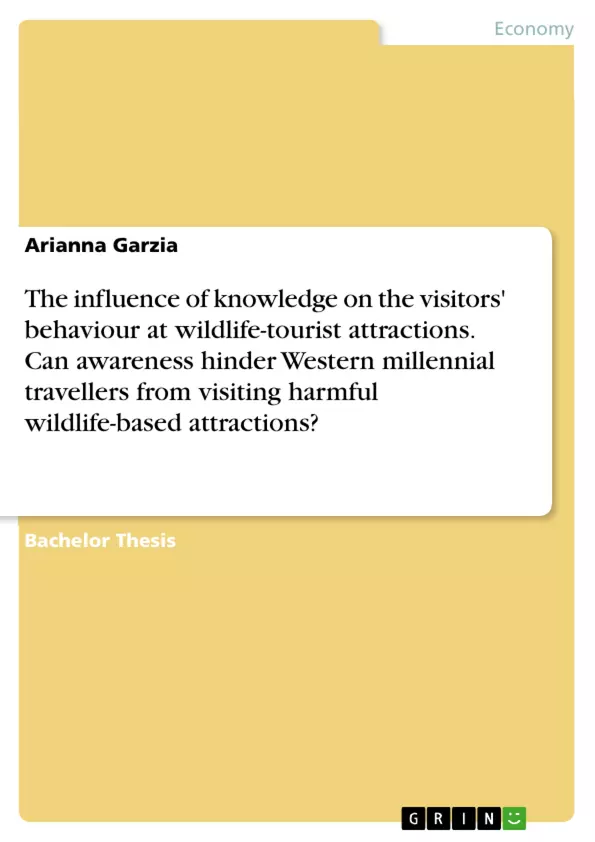Wildlife-based tourism currently represents one of the fastest growing travel sectors, expected to increase by at least 10% annually. The high demand for animal encounters is mostly caused by the soaring number of international tourist arrivals and the search by travellers for new and memorable experiences in contact with nature. Among travellers, millennials have gained particular importance in the tourism industry due to the high frequency of their journeys, the considerable amount of money spent and their quest for authentic and learning experiences while travelling. Therefore, this generation may contribute to the growing request for Wildlife-Tourist Attractions (WTAs) worldwide.
Due to the development of WTAs on a global scale, they are increasingly receiving huge criticism from animal welfare advocates because of their exploitation of the animals’ rights and poor welfare conditions. However, the alarming lack of knowledge about negative visitors’ impacts on the wildlife and about animal welfare assessment, along with the high percentage of excellent reviews on TripAdvisor, encourage tourists to indulge in wildlife encounters that are highly detrimental.
Due to the considerable share of millennials in tourism and the impact of culture on behaviour, only Western millennials have been considered for the purpose of this study. In connection with the aim of this thesis, the three following main research questions have been formulated:
RQ1. How important is good animal welfare for Western millennial travellers at WTAs?
RQ2. How does knowledge influence the behaviour of Western millennial visitors at WTAs?
RQ3. How do positive and negative reviews on TripAdvisor influence Western millennials to visit WTAs?
Inhaltsverzeichnis (Table of Contents)
- PREFACE AND ACKNOWLEDGEMENTS
- EXECUTIVE SUMMARY
- CHAPTER 1: INTRODUCTION
- 1.1 Wildlife Tourism
- 1.2 Millennials' Importance in Tourism
- 1.3 Wildlife Tourist Attractions
- 1.4 The Problem
- 1.5 The Research Questions
- 1.6 Structure of the Thesis
- CHAPTER 2: LITERATURE REVIEW
- 2.1 The Theory of Planned Behaviour
- 2.2 Attitude- Behaviour Gap
- 2.3 Animal Welfare Assessment
- CHAPTER 3: METHODOLOGY
- 3.1 Research Design
- 3.2 Data Collection
- 3.3 Data Analysis
- CHAPTER 4: RESULTS AND FINDINGS
- 4.1 Profile of the Sample
- 4.2 Theme 1: Motivations for Visiting WTAs
- 4.3 Theme 2: Definition of Good Animal Welfare
- 4.4 Theme 3: Factors Influencing the Perception of Good Animal Welfare
- 4.5 Theme 4: Knowledge About Negative Impacts
- 4.6 Theme 5: Knowledge about TripAdvisor
- 4.7 Theme 6: The Existence of Attitude- Behaviour Gaps
- CHAPTER 5: DISCUSSION
- 5.1 Main Findings and Their Importance
- 5.2 Limitations and Recommendations
- 5.3 Recommendations for Wildlife Organizations
Zielsetzung und Themenschwerpunkte (Objectives and Key Themes)
This Bachelor thesis investigates the impact of knowledge on the behaviour of Western millennial travellers visiting wildlife-based attractions. The study aims to determine whether awareness can influence individuals to avoid participating in activities that potentially harm animal welfare. The research focuses on understanding how Western millennials perceive animal welfare, how knowledge affects their decisions, and the role of TripAdvisor reviews in their choices.- The importance of good animal welfare for Western millennial travellers at wildlife tourist attractions.
- The influence of knowledge on the behaviour of Western millennials visiting wildlife tourist attractions.
- The role of positive and negative reviews on TripAdvisor in influencing Western millennial travellers' decisions to visit wildlife tourist attractions.
- The factors contributing to attitude-behaviour gaps, where individuals' intentions to act ethically when travelling clash with their final actions.
- The challenges of measuring animal welfare and the perception of good versus poor animal welfare.
Zusammenfassung der Kapitel (Chapter Summaries)
Chapter 1 introduces the concept of wildlife tourism and highlights the importance of millennials in the tourism industry. It further explains the growing concern surrounding wildlife tourist attractions (WTAs) and their potential negative impacts on animal welfare. The chapter concludes by formulating the research questions that guide the thesis. Chapter 2 provides a comprehensive review of relevant literature. It explores the "Theory of Planned Behaviour" and discusses the concept of attitude-behaviour gaps. The chapter also examines existing methods for assessing animal welfare. Chapter 3 outlines the methodology used for this research, including the research design, data collection methods, and data analysis techniques. Chapter 4 presents the findings of the study based on interviews with thirteen Western millennials. The chapter explores the motivations for visiting WTAs, the participants' understanding of good animal welfare, the factors influencing their perception of animal welfare, and the impact of knowledge about negative impacts and TripAdvisor reviews on their behaviour. Chapter 5 discusses the main findings and their implications, highlighting the importance of knowledge in shaping attitudes and behaviours towards wildlife tourist attractions. The chapter concludes by suggesting recommendations for future research and for wildlife organizations working to promote responsible tourism practices.Schlüsselwörter (Keywords)
This research examines the complex relationship between knowledge, attitudes, and behaviour in the context of Western millennials visiting wildlife tourist attractions. The study delves into the impact of awareness on decision-making, explores the concept of attitude-behaviour gaps, and investigates the role of TripAdvisor reviews in influencing visitors' choices. Key themes include animal welfare assessment, responsible tourism, wildlife tourism, millennial travel behaviour, and the impact of social media on travel decisions.- Quote paper
- Arianna Garzia (Author), 2018, The influence of knowledge on the visitors' behaviour at wildlife-tourist attractions. Can awareness hinder Western millennial travellers from visiting harmful wildlife-based attractions?, Munich, GRIN Verlag, https://www.grin.com/document/442655



